Construction Polymers, a Primer
What Determines the Characteristic Properties of
Construction Polymers?
Overlays or patching materials of new Portland Cement Concrete (PCC), terrazzo, mortar, grout and extruded curb based on Type I through Type V cements or White Cement may be structurally bonded with liquid epoxy adhesives to existing concrete surfaces. Most cementitious admixtures in Types A through E defined in ASTM C-494 are compatible with epoxy when employed in normal concentrations. The existing surface may be lightweight or dense portland cement concrete, asphaltic concrete (AC), steel, stone, wood or composite combinations of these materials. The bond line may be vertical, oblique or horizontal and can be on or below grade. The American Concrete Institute offers a similar set of recommendations: ACI 548.13-14.

How did Construction Polymers Get their Names?
| Name | Description |
|---|---|
| Epoxies | From the epoxy groups in these resins which are capable of establishing links to the hardener. |
| Polyurethanes | From the name of the link (urethane) that is formed when isocyanate group containing resins and resins containing hydroxyl groups (polyols) react. |
| Polyureas | From the name of the link (urea) that is formed when isocyanate group containing resins and resins containing amine groups react. |
| Acrylics | From the name of the acid (acrylic acid) which is common in all of these products. |
| Silanes | From the chemical name of these products. |
| Siloxanes | From the name of the partial hydrolysis products of silanes. |
| Silicones | From the name of the hydrolysis end-product of silanes and siloxanes. |
| Latex polymers | From the name of the chemical used to make the polymer. A latex is a water emulsion of such polymers. |
Key Advantages and Disadvantages of Construction Polymers
| Polymer type | Advantage | Disadvantage |
|---|---|---|
| Epoxy (100% solids) | High strength, HDT, Bonds to wet or underwater surface, Excellent chemical resistance, Low cure shrinkage | May fade or yellow, Slow cure |
| Epoxy (water dispersions or emulsions) | Low viscosity, Environmentally friendly, Easy clean-up | Low viscosity, Environmentally friendly, Easy clean-up |
| Epoxy (water dispersions or emulsions) | Low viscosity, Environmentally friendly, Easy clean-up | Yellows, Limited chemical resistance, Slow cure |
| Polyurethane | Flexible, Tough, Abrasion resistant | Poor bond, Moisture caused gas formation, May yellow |
| Polyurea | Flexible, Tough, Abrasion resistant Fast cure | Limited bond, Needs primer in critical use, Limited chemical resistance, Yellows |
| Polyester (Vinylester) | Tough, Best chemical resistance, Good overlay material | Shrinks, Need primers, Styrene odor, Toxicity concerns |
| Acrylics (reactive) | Don't yellow, Low viscosity, Fast cure, Reactive concrete consolidants when epoxy injection is too expensive | Odor, Some are brittle, Expensive, Cure can be inhibited, Low chemical resist |
| Acrylic latex | Best cement product modifier, Permeability, Environmental resistance | Limited freeze-thaw, Low chemical resistance |
| Silicone resins | Best long life sealant, Color stability, No age hardening | Expensive, May need primer |
Material Properties and Behavior
Most construction polymers have thermoset character–this is especially critical for structural uses. Exceptions are very flexible epoxies, some polyurethanes, polyureas, hybrids of these materials and some latex polymers. The latter are thermoplastic or nearly so.
Thermoset polymers products are made up of highly cross-linked molecular elements, maintain their shape when heated, but do not melt. Above about 240 to 300° F they decompose. Thermoset polymers are rigid (high modulus of elasticity), somewhat brittle at low temperature and have limited flexibility at higher temperatures. The mid-point of the temperature range at which the transition from rigid to flexible takes place is called the glass transition temperature.
The Heat Deflection Temperature (HDT) is a simple indicator of the glass transition temperature. Most construction polymers have a HDT in the range between 65 and 120°F. At temperatures in and above the glass transition region, construction polymers subjected to high loads will deform which leads to loss of bond and ultimate failure of the application.
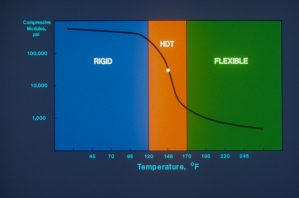
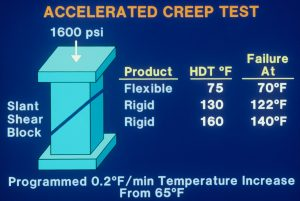
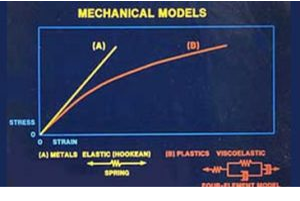
The fact that many construction polymers are used in the glass transition temperature range should always be considered when recommending a material. Know the HDT of the product you want to use. Many failures can be traced to a disregard of the material behavior changes that occur in this temperature region.
Significantly below the HDT (~20°F) thermoset polymers can withstand substantial loads without deformation (creep) which is the basis for their structural use in construction (crack repair, bolt and dowel grouting, bonding applications).
Except for truly elastomeric products, all construction polymers have more or less pronounced visco-elastic character. When stressed they do not entirely respond in the manner an elastic body(spring) would and they don’t flow in the manner of a liquid (response like a shock absorber to a bump).
The response of a construction polymer to a stress (load) is partly elastic and partly of viscous nature. The prevalence of each of the components in response to a stress (load) depends on the composition of the polymer, the stress level, the stress exposure duration, and temperature. Short term loads generate a quick elastic response. The response to long term loads is seen in creep which is a form of viscous flow.
As a consequence of their visco-elastic nature, construction polymers have time and temperature dependent properties. Typical rigid stress-strain behavior at low temperature changes to elastomeric behavior at high temperature, while increased in strain rate at a given temperature produce a increasingly rigid response. All visco-elastic construction polymers have temperature ranges where they are rigid or flexible. The glass transition temperature separates the two ranges.
In structural applications, it is important that the construction polymer does not creep under sustained load. The tendency to creep depends on the load level and the prevailing temperature. Each material has an envelope where creep does not produce failure at a given temperature and load level.
Construction polymers used in “load bearing” applications should have a high HDT. When such polymers are subjected to permanent loads, particularly when these loads have a high shear component, the surrounding structure element should always remain at least 20° F below the HDT. In critical applications and as a safety measure in case of a fire, thermal protection should be provided. In recognition of the material performance needs in load bearing applications, ChemCo Systems products were deliberately designed to have higher HDTs than are typically offered by the industry.
Thermoplastic polymers melt when heated and return to their original state when cooled again, unless they were heated to a point above their decomposition temperature. Their glass transition temperature is very low (<-40° F). Thermoplastic and slightly cross-linked thermoplastics have largely predictable properties in normal construction polymer use temperatures because they are used above their glass transition temperature. Exceptions are polymers with crystalline segments within their molecular structure that melt in this region. They are more or less elastic (low modulus of elasticity) and get largely employed for this property (elastomer membranes, joint materials, roofing compositions, seals).
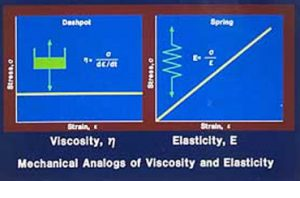
Liquid/Solid Transition During Cure - Cure shrinkage
When a liquid solidifies (except water) a contraction ensues. This contraction is called cure shrinkage and is inevitable unless counteracted (which is difficult and very expensive). Cure shrinkage varies among types of polymers:
| Type | Volume Shrinkage, % | Linear Shrinkage, % |
|---|---|---|
| Epoxy | 4 - 5 | 0.1 |
| Acrylic | 6 - 9 | 0.2 |
| Polyester | 9 - 14 | 1.0 |
| Polyurea | 7 - 10 | 0.3 |
Volume shrinkage during cure is of significance when the curing construction polymer is in a confined space (void, gap, crack, joint, patch) and documents itself by a meniscus formation on the surface.
Linear shrinkage is an indication of the true shrinkage which takes place after the curing liquid has no longer enough mobility to flow to compensate for the shrinking volume. This form of shrinkage stresses the bond between the substrate and the construction polymer and can lead to bond or in extreme cases to substrate surface failure.
Flexible systems can respond to cure shrinkage by getting into a partial state of extension, which in time relieves itself by viscous flow (“stress relief”). Rigid, high modulus systems respond by placing significant stress on the bond line or in the substrate surface that can lead to bond-line or substrate failure. To compensate for cure shrinkage many rigid systems are extended with inorganic fillers (or sometimes aggregates by the contractor) that reduce the volume fraction of the polymer.
Exotherm
The cure of construction polymers is normally associated with heat formation (exotherm). In cross-linked, thermoset systems this phenomenon places an additional stress on the bond-line/substrate surface, because the product sets in a temperature expanded state which comes into play when the product cools to the normal ambient.
Thermal Expansion Coefficient
Construction polymers have an expansion coefficient that is 4 – 10 times larger than that of concrete. When bonded to a concrete substrate this difference can cause failures when significant temperature variations are encountered. Rigid, high HDT construction polymer installations are most prone to fail under these circumstances, unless heat formation during cure, the bond-line thickness and the polymer volume fraction are properly controlled. Aggregate filling (often up to 90% by weight) can shift the epoxy system expansion coefficient to nearly the same as that of concrete.
Combined Effects of Polymer Volume Fraction, Expansion Coefficient, Exotherm, Cure Shrinkage and Modulus.
In specifying use of a particular construction polymer for critical application, the potential for significant interaction of the material’s expansion coefficient, the mass involved, the exotherm on cure, the cure shrinkage and its modulus (and change with temperature) must be considered.

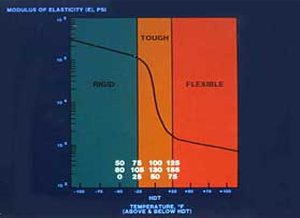
Physical Properties
| Name | Concrete | Structural | Flexible | Elastomeric |
|---|---|---|---|---|
| Modulus of Elasticity | 4,000,000 | 400,000 | 60,000 | 600 |
| Expansion Coefficient | .000,004 | .000,02 | .000,04 | .000,05 |
| Tensile Strength | 400 | 8,000 | 1,500 | 1,500 |
| Elongation | nil | 1-2 | 35-100 | 400 |
| Shear Strength | 800 | 1,500 | 1,200 | NA |
| Flexural Strength | 1,200 | 4,000 | NA | NA |
| Compressive Strength | 4,000 | 14,000 | 5,000 | NA |
Tell us about your project
CALL 650-261-3790.

